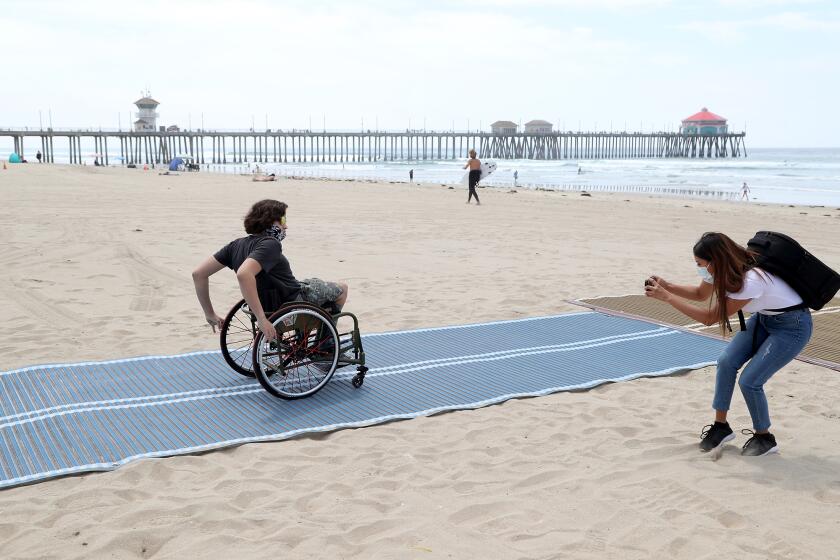Artist discusses his digital and 3-D take on Orange County landscape
- Share via
The starting point was walking the coastline of Orange County’s beach cities.
Roughly six years ago, artist Jesse Colin Jackson was teaching a class at UC Irvine in which a group of students, who either grew up or moved to O.C., grappled with the question: How does an artist respond to the place they live?
Jackson had moved to O.C. from Canada in 2013 and started to answer the question for himself. He walked along San Clemente, Dana Point, Laguna Beach, Newport Beach, Huntington Beach and Seal Beach — shooting eight panoramic photos per city, then combining the eight shots to form one digital composition in “The Orange Coast” series.
The six images are one of the pieces included in Jackson’s “Suburban Ecologies” exhibit at the city-owned Great Park Gallery in Irvine.
“Jackson’s subject matter has the potential of being accessible to a range of viewers,” stated curator Adam Sabolick via email. “The Orange County coastline, Santa Ana River and Orange County suburbia are familiar subjects to the region.”
The gallery is closed, but a video tour is available online. It shows a sculpture of the Santa Ana watershed at the center surrounded by photos and video of a hike up the Santa Ana River fall line in the background.
The watershed sculpture opens to “The Orange Coast” images hung on the gallery wall. A separate smaller room is dedicated to the pre-planned communities of Irvine with digital images of suburban housing and a second sculpture.
At the entrance, a wall panel of waste material from 3-D printed face shields in a geometric pattern is hung to commemorate the UC Irvine project Jackson led early on the pandemic. The face shields were created for local medical professionals.
“I am interested in creating connections between the lives we live and the territory we have arguably colonized in this case,” Jackson said. “Colonists of Orange County — we’ve literally reorganized the topography. The river is a great example of this. It’s actually very difficult to figure out where the river would have been prior to channelizing ... The river introduces all sorts of complications about what organizes Orange County and how we’re connected to this bigger region in a very specific way. All of the water that comes from the mountains has to flow through Orange County to get to the ocean.”
The centerpiece sculpture, “Marching Cubes Watershed #2: Santa Ana,” is an exaggerated 3-D model made out of the same material Jackson used in a previous “Marching Cubes” installation. He was inspired by how central the river was to the county’s history from being a fertile plain for Acjachemen and Tongva groups to being the source of irrigation for ranches and agriculture and eventually dammed at the O.C. and Riverside juncture.
While it has served as an open space for recreation (walking, biking and hiking), in recent years it became a homeless encampment that the county pushed to clear.
“I’ve been in a long conversation with a local anthropologist named Valerie Olson, who has been looking at the politics and the kind of lives lived around this river,” Jackson said.
Their conversation will continue at 6 p.m. on March 10 in an online artist talk between Jackson, Olson and Sabolick.
If you watch
What: Suburban Ecologies
When: March 10 at 6 p.m.
Where: Zoom webinar
Cost: Free
Info: illuminations.uci.edu/events/2021_3_10_Suburban_Ecologies.html
All the latest on Orange County from Orange County.
Get our free TimesOC newsletter.
You may occasionally receive promotional content from the Daily Pilot.






